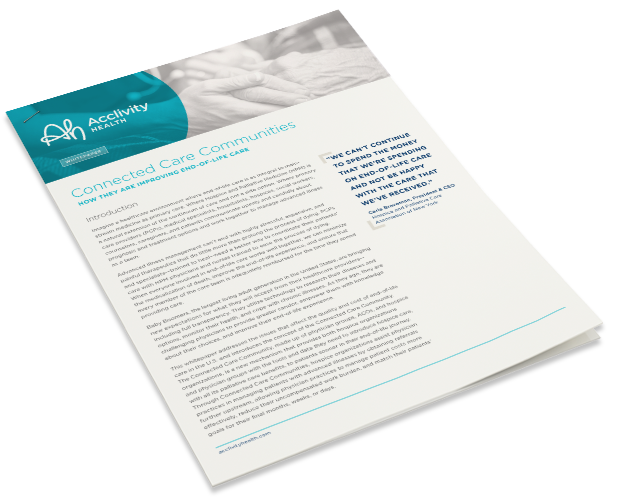Eighty percent. That’s how many Americans would like to die at home. But despite the fact that 70 percent of Americans die from chronic illnesses1, giving them time to anticipate their deaths, over 50 percent still die in hospitals or nursing homes.2 Of the Medicare patients who died in 2016, only 48% received hospice services at the time of death3, even though every patient was eligible for six months of hospice care.
Prior to 1950, the majority of Americans did die at home. At that time, many chronic and advanced illnesses were untreatable, and all physicians could offer was palliative care. Over the next few decades, innovations in medicine enabled doctors to prolong life with medical and surgical interventions and for hospitals to treat patients with ventilators and IV anesthesia. As seriously ill patients lived longer, medical institutions recognized advanced illness management as an effective way to maximize their profits.
Over time, Americans became complicit in giving hospitals and skilled nursing facilities the responsibility for determining how we die. We avoided confronting our mortality and focused on increasing our longevity. Culturally, the topic of death became morbid—something polite people did not discuss.
“Scientific advances have turned the processes of aging and dying into medical experiences, matters to be managed by health care professionals. And we in the medical world have proved alarmingly unprepared for it… If your problem is fixable, we know just what to do. But if it’s not? The fact that we have had no adequate answers to this question is troubling and has caused callousness, inhumanity, and extraordinary suffering.” – Dr. Atul Gawande, Being Mortal—Medicine and What Matters in the End
With 74 million Baby Boomers in or approaching retirement, we can’t afford—psychologically or financially—to keep the conversation in the closet. We need to develop systems for helping Americans engage with the end of our lives as deliberately as we prepare for every other stage of life. To start, patients need to create advanced health care directives confirming their goals early on, and doctors need to encourage their patients to keep them up to date.
Today, fewer than 10 percent of all medical school programs in this country train doctors in end-of-life care areas or how to tell their patients they are dying4. While more medical schools need to add this coursework to their curriculums, we also need to make it easier for physicians to integrate Hospice and Palliative Medicine (HPM) into the continuum of care.
HPM, which provides home-based palliative, emotional and spiritual care to patients, can be introduced at any time after an advanced illness has been detected. It not only saves patients from ineffective treatments, but also reduces unnecessary ER visits and hospitalizations, ineffective treatments and ease patients’ suffering.
Hospice utilization is growing, with over 47% of Medicare decedents receiving some hospice care in 20175. But while that growth is promising, referral to hospice still has a long way to go. A four-year study of the Medicare 5% Limited Dataset (LDS) by the Society of Actuaries® showed “33% of FFS Medicare-eligible seniors with malignancies under active treatment were not enrolled in the Hospice program prior to their deaths.”6 Additionally, in 2016, 27.9% of patients referred to hospice had only 1 to 7 days of care prior to their deaths, and the median length of hospice utilization was only 24 days.7
Education and collaboration are the keys to creating a new culture where death is accepted as a natural process. When primary care providers (PCPs), medical specialists, hospitalists, hospices, social workers, counselors, caregivers, and patients can communicate openly and candidly about personal goals and values, prognoses and treatment options, they have the best chance of determining the most appropriate approach for each patient’s end-of-life care.
[1] Center for Disease Control. (2009). The Power of Prevention: Chronic Disease ...The Public Health Challenge of the 21st Century [Pamphlet]. Retrieved January 24, 2019, from: <https://www.cdc.gov/chronicdisease/pdf/2009-Power-of-Prevention.pdf>
[2] National Center for Health Statistics. Health, United States, 2017: With special feature on mortality. Hyattsville, MD. 2018. Retrieved January 30, 2019, from: <https://www.cdc.gov/nchs/data/hus/hus17.pdf> (p 30) and <https://www.cdc.gov/nchs/data/hus/2017/fig30.pdf>
[3] Facts and Figures: Hospice Care in America (Rep.). 2017 [PDF File]. National Hospice and Palliative Care Organization. Retrieved January 25, 2019 from: <https://www.nhpco.org/sites/default/files/public/Statistics_Research/2017_Facts_Figures.pdf>
[4] Christine Cowgill, MS, CRC. Urgent Need for Beter End of Life Training. Today’s Geriatric Medicine. Retrieved February 4, 2019 from http://www.todaysgeriatricmedicine.com/news/ex_062613.shtml
[5] Baxter, A., & Baxter, A. (2018, June 04). 2017 Hospice and Home Health Medicare Utilization Trends. Home Health Care News Retrieved January 24,2019, from: <https://homehealthcarenews.com/2018/06/2017-hospice-and-home-health-medicare-utilization-trends/>
[6] William R. Bednar, Joshua W. Axene, Richard L. Liliedahl, M.D. ; October 2018 [PDF File] ; Hospice Care Research: An Analysis of End-of-Life Costs for Terminally Ill Medicare Fee-for-Service (FFS) Cancer Patients. Retrieved January 24, 2019 from: <https://www.soa.org/Files/resources/research-report/2018/hospice-care-report.pdf>
[7] Facts and Figures: Hospice Care in America (Rep.). 2017 [PDF File]. National Hospice and Palliative Care Organization. Retrieved January 25, 2019 from: <https://www.nhpco.org/sites/default/files/public/Statistics_Research/2017_Facts_Figures.pdf>


